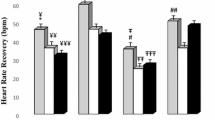Abstract
Purpose. The purpose of this study was
-
1.
To check wether subjects reached a constant heart rate (f h ) during 6 min constant work load (\(\dot W\)) at 3 submaximal levels of intensity.
-
2.
To investigate the comparability of functional load in boys of same age with different body weight as response to external load in watts per kilogram body weight.
-
3.
To calculate the regression equation(s) with \(\dot W\) as independent variable and f h as dependent variable.
Methods. External load: bicycle ergometer exercise, 3 discontinuous series of increasing loads, 1.0, 1.5, and 2.0 W/kg, duration 6 min each with intermittent rest periods of 1 min. Functional load: R-R interval (msec) from precordial E.C.G. Subjects: 12 and 13 year old schoolboys, n=80, divided into body weight groups of 30, 35, 40, 50 and above 50 kg.
Results
-
1.
During the last four 30 sec periods of each workload no constant R-R interval could be established; the decrease was significant at p=0.001.
-
2.
No significant differences (p>0.05) in mean heart rate at 3 work loads could be proved between the 6 weight groups; the total variance is mainly explained by variance between subjects in same weight group (55%) and by variance with in subjects (35%).
-
3.
The \(\dot W\) 170 of all subjects, calculated from the regression equation was 2.0 W/kg body weight.
Zusammenfassung
Ziel. Das Ziel war, die Vergleichbarkeit zu untersuchen von Arbeitsfähigkeit und Arbeitsbelastung, in Watt per Kilogramm Körpergewicht, bei Jungen im gleichen Alter, aber mit unterschiedlichem Körpergewicht.
Methoden. Arbeitsbelastung: Fahrradergometer-Arbeit in 3 Reihen, Belastungen, die je 6 min dauern von 1,0, 1,5 und 2,0 W/kg, mit einer Pause von je 1 min zwischen den Reihen. Arbeitsfähigkeit: R-R-Intervall (msec) von präkordialem EKG. Personen: 12- und 13jährige Schüler, n=80, verteilt in Körpergewichtsgruppen von 30, 35, 40, 45, 50 und über 50 kg.
Ergebnisse
-
1.
Während der letzten der letzten vier 30 sec-Perioden von jeder Belastung konnte kein konstantes R-R-Intervall bestätigt werden; die Abnahme war signifikant mit p=0,001.
-
2.
Zwischen den 6 Körpergewichtsgruppen konnten keine signifikanten Unterschiede (p>0,05) in mittlerer Herzfrequenz bei den 3 Belastungen nachgewiesen werden; die ganze Varianz konnte hauptsächlich erklärt werden durch Varianz zwischen Personen in derselben Körpergewichtsgruppe (55%) und durch Varianz innerhalb der Personen (35%).
-
3.
Die körperliche Leistungsfähigkeit (W170) von allen Personen, berechnet aus der Regressionsgleichung, war 2,0 \(\dot W\) Kilogramm Körpergewicht.
Similar content being viewed by others
References
Adams, F. H., Linde, L. M., Miyaki, H.: The physical working capacity of normal schoolchildren. I. Calif. Pediat. 28, 55–64 (1961).
Adams, F. H., Bengtsson, E., Berven, H., Wegelins, C.: The physical working capacity of normal schoolchildren. II. Swedish city and country. Pediatrics 28, 243–257 (1961).
Andersen, K. L.: I.B.P. Handbook. Measurements of maximal oxygen uptake and related respiratory and circulatory functions. Bergen: Institute of Physiology 1967.
Bleeker, J., Bonjer, F. H.: Een ijkapparaat voor het controleren en afregelen van ergometers (calibration of bicycle ergometers). Polytechn. Tijdschrift A: 637 (1960).
Bonjer, F. H. (ed.): Fysiologische methoden voor het vaststellen van belasting en belastbaarheid (Physiological methods for measuring load and capacity). Assen: van Gorcum 1965.
Brouha, L., Radford, E. P., Jr.: In: Science and Medicine of exercise and sports, p. 198. New York: Harper and Row 1960.
C.A.H.P.E.R.: The Physical work capacity of Canadian children. The Canadian Association for Health, Physical Education and Recreation, 1968.
Ishiko, T., Nakagawa, A.: PWC170 of Japanese Youths. F.I.M.S. congres, Oxford 1970.
Máček, M., Vávra, J., Žíka, K.: The comparison of the W170 values during growth. J. Sports Med. 7, 69–74 (1971).
Mellerowicz, H.: Der Kreislauf des Jugendlichen bei Arbeit und Sport, p. 58. Basel: Karger 1965.
Mocellin, R., Rutenfranz, J., Singer, R.: Zur Frage von Normwerten der körperlichen Leistungsfähigkeit (W170) im Kindes- und Jugendalter. Z. Kinderheilk. 110, 140–165 (1971).
Newens, E. M., Goldstein, H.: Height, weight and the assessment of obesity in children. Brit. J. prev. soc. Med. 26, 33–39 (1972).
Placheta, Z., Novák, A., Drazil, V., Stich, Z.: Einige Probleme der Funktionstests bei submaximaler Belastung. Med. u. Sport 5, 153–157 (1971).
Wahlund, H.: Determination of the physical working capacity. Acta med. scand., Suppl. 215 (1948).
Wieringen, J. C. van: Gewicht naar lengte en leeftijd (Weight versus height und age). T. soc. Geneesk., Suppl. 1, 47, 43–49 (1969).
Author information
Authors and Affiliations
Rights and permissions
About this article
Cite this article
Kemper, H.C.G. Heart rate during bicycle ergometer exercise in watts per kilogram body weight of 12 and 13 year old boys. Z. Kinder-Heilk. 113, 161–169 (1972). https://doi.org/10.1007/BF00464619
Received:
Issue Date:
DOI: https://doi.org/10.1007/BF00464619




